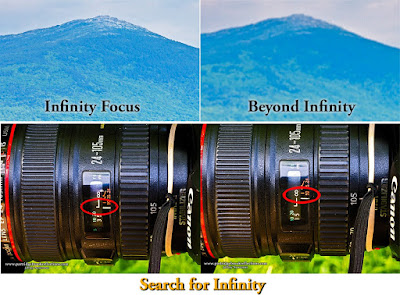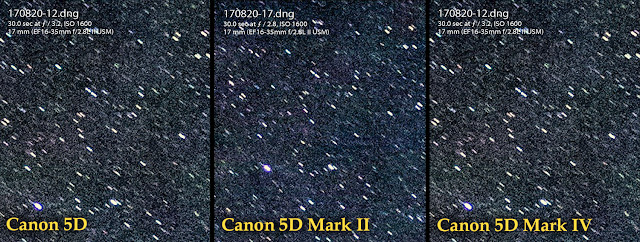 |
| My Yard, Window on the Galaxy |
The
idea for his week’s blog was triggered by a simple desire to assess how the
amount of digital noise has changed from my original Canon 5D to my current
beloved 5D Mark IV. Published reviews all testify to the greatly improved
low light capabilities of the newer cameras, but I thought that it would be
interesting to test this myself, specifically with the high ISO, long exposure
images required for Milky Way photography. That was my simple goal, but I
can never keep articles short and simple. So, since it is the season, I
couldn’t resist discussing a few basic points about capturing the unique beauty
of the Milky Way.
Milky
Way Season
 |
| Connecticut River, Walpole NH |
In
New England, summer is a good time to shoot the Milky Way. Of course, the
most spectacular portion of the galactic disk is highest in the Northern
Hemisphere sky in late spring, but summer has the advantage of warmer nights.
As we get later in autumn, the galactic core drifts below the horizon
and, although a segment of the Milky Way is always visible in the night sky, we
have to endure a long cold winter before the most spectacular portions are again
visible.
 |
| All About the Foreground |
This
time of year, I’m always watching for the combination of clear skies and a dark
moon for my best Milky Way images. Then it becomes a matter of finding
something interesting to put in the foreground. A couple of weeks ago I
went again to Chesterfield’s iconic town hall. The angle which
incorporated the galaxy had some foreground lights, but I was able to
de-emphasize them in post.
Maximum
Shutter
Milky
Way photography is actually very easy. The beauty and detail of the
galaxy becomes progressively apparent with larger apertures, high sensor
sensitivity (ISO), and longer exposures,
but with longer shutter times, the stars will blur and begin to show star
trails. This can be an interesting effect with especially long exposures,
but it is not what you want with Milky Way images.
Wide
angle lenses are key to minimizing star movement with long exposures and I
always shoot with my 16mm lens. The
standard equation to calculate the maximum exposure for any particular focal
length is the “Rule of 600”
Exposure
(sec) = 600 / focal length
For
my 16mm lens, 600 / 16 = 37.5 seconds
Many
photographers, including myself, suggest that 600 is too high. They
recommend a “Rule of 500”. I always keep
my exposures between 20 – 30 seconds.
 |
| Hot Tub View, 20 Seconds |
At 30 seconds, the numerator would be just 480. Increasingly I am using a
20 second exposure, which make me a “Rule
of 320” person. You can compare
various exposures for yourself. The best
shutter speed will depend on how far you plan to enlarge the image. You can get away with a lot for a small web
shot, but be sure you won’t, at some point, want to blow up the image to a large
fine art print. Just remember that, as exposure becomes shorter, a higher ISO
will be required to get adequate exposure. That means more digital noise. Photography is always about finding the best compromise.
 |
| Shutter Speed Comparison, !6mm, Full Frame |
Check
out the comparison images from 10 seconds to 5 minutes all zoomed to 100% in
Lightroom. For me the 20 second
exposure, with a 16mm lens, seems the best compromise.
Ok.
Now aim your standard 50mm lens at the stars and you can, at best, get away
with a 12 second exposure. Up goes the ISO.
Remember the
Crop
 |
| Martha's Vineyard |
Finally,
it is important to understand that these calculations are based on shooting
with a full frame sensor. If you are using a crop sensor camera, you will
need to apply the crop factor to the calculation to match the effective
focal length. On a Canon Rebel, the crop factor is 1.6, so my 16mm lens
becomes an effective, 16 x 1.6= 25.6mm and using my rule of 320 the maximum
exposure becomes 12.5 seconds.
Finding
Infinity
It
is easy to experiment with different shutter speeds, but try to balance the shortest
exposure with an acceptable ISO. Also with  proper infinity focus you can
use YOUR LEN’S widest aperture. The stars are many light years
away, infinity should work just fine. Just remember that on most lenses,
especially zooms, the true infinity point
is not at the lenses maximum rotation point. You can find your lenses true
infinity by visually focusing on a distant bright light or star. Many lenses have a check mark next to the
infinity icon that should be close to the actual true point. I know my
infinity point on my 16-35mm lens and I tape it to that spot before I go out to
shoot the sky.
proper infinity focus you can
use YOUR LEN’S widest aperture. The stars are many light years
away, infinity should work just fine. Just remember that on most lenses,
especially zooms, the true infinity point
is not at the lenses maximum rotation point. You can find your lenses true
infinity by visually focusing on a distant bright light or star. Many lenses have a check mark next to the
infinity icon that should be close to the actual true point. I know my
infinity point on my 16-35mm lens and I tape it to that spot before I go out to
shoot the sky.
 proper infinity focus you can
use YOUR LEN’S widest aperture. The stars are many light years
away, infinity should work just fine. Just remember that on most lenses,
especially zooms, the true infinity point
is not at the lenses maximum rotation point. You can find your lenses true
infinity by visually focusing on a distant bright light or star. Many lenses have a check mark next to the
infinity icon that should be close to the actual true point. I know my
infinity point on my 16-35mm lens and I tape it to that spot before I go out to
shoot the sky.
proper infinity focus you can
use YOUR LEN’S widest aperture. The stars are many light years
away, infinity should work just fine. Just remember that on most lenses,
especially zooms, the true infinity point
is not at the lenses maximum rotation point. You can find your lenses true
infinity by visually focusing on a distant bright light or star. Many lenses have a check mark next to the
infinity icon that should be close to the actual true point. I know my
infinity point on my 16-35mm lens and I tape it to that spot before I go out to
shoot the sky.
The Noisy
Sky
| Dublin Lake |
I
typically shoot the Milky Way with an ISO ranging between 1600 and 3200 and,
even with my lovely Canon 5D Mark IV, that still means digital noise. I
always use my camera’s noise reduction setting.
To reduce camera shake, I select Mirror Lockup and turn off image stabilization. The digital noise
can still be bothersome, but the newest noise reduction algorithms in Lightroom
and Photoshop can make a significant difference. As always, it is a
balancing act, since heavy noise reduction can lead to a loss of crispness in
the image.
The
good news is that newer sensors are getting better at reducing the high ISO noise.
I have watched this progress as I have move through a series of 5Ds, from
5D to the Mark II and now the Mark IV. I have always had the sense that
the noise was getting better, but I thought this might be a good time to check
this in the context of Milky Way images.
HENCE this
Article
I
know that this has been a long way to get to the point, but, for context, I
couldn’t resist a quick review of the essentials.
My 32000 ISO
Mistake
 |
| Chesterfield Town Hall ISO 32000 |
The
idea of comparing high ISO noise was triggered by a mistake. While
shooting the Milky Way beyond the Chesterfield Town Hall, I intended to use an
ISO of 3200, but instead, I set the sensitivity to 32000! I was perplexed
by the adjustments that I needed to make for a balanced exposure, but then my
mistake finally hit me. Back home I was struck by the fact that the noise
at 32000 was not all that bad. My wonderful Mark IV ! – Worth every penny
– actually, too many pennies.
My
camera is great, but I wondered how much better it was compared to my previous
versions of my “wonderful” camera. Since I am a pack rat and never throw
my old stuff onto eBay, I still had all my 5Ds. So, let’s compare.
I
set my tripod and recorded the same sky with all three cameras at the same
settings, 16mm, f2.8, 30 seconds and ISO at 1600. I would have preferred
to use a higher ISO, but that is as high as my original 5D will go.
Results
I
was surprised at how little difference I could see between camera, even at 2-1
zoom and I REALLY wanted and expected to see an improvement with my fancy new
camera. Reluctantly, I was forced to
conclude that there was much difference in noise at an ISO of 1600.
 |
| Digital Noise at ISO 1600 |
Maybe I
would see a difference at higher ISOs. I
lost my trusty old 5D, but, the next night, I was able to test the noise at my
Mark II’s maximum ISO of 6400. Happily,
to my eye, Mark IV has less noise and generally crisper detail. Ok, the difference is not earth shattering,
but leave me alone! - the 5D Mark IV is great for lots of other reasons as
well.
Since
I didn’t get to see the full solar eclipse, it was fun to play with another
remarkable celestial phenomenon and one I don't have to wait another seven years to see again. I hope
it gets you excited about using the power of digital photography to deeply gaze
into the universe before the galactic core retreats below the horizon.
For
more information about shooting the night sky, check out my previous articles:
Jeffrey Newcomer




Smartphone Lenses
ReplyDeleteI don't like gambling or some uncertainty things like that. It looks like we depends on invisible thing..Smartphone Lenses
ReplyDelete